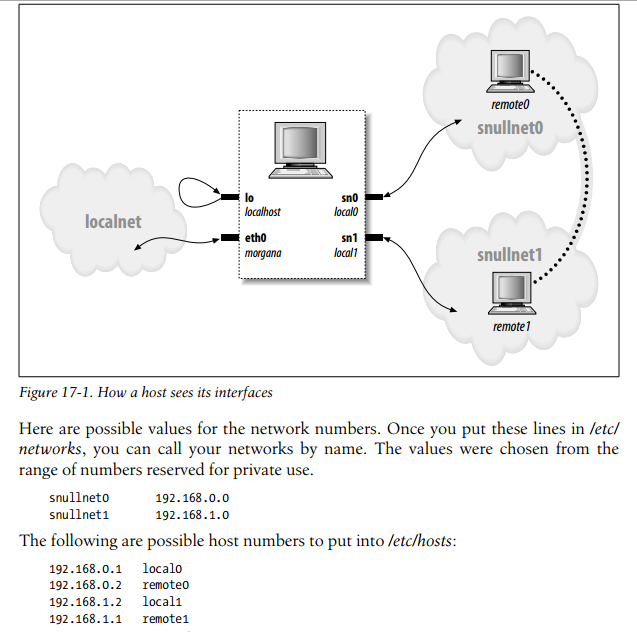网络驱动是Linux系统中一种重要的设备驱动,它用来实现对网络设备的控制和数据传输,如网卡,交换机,路由器等。网络驱动的开发涉及到网络协议栈,套接字接口,网络设备结构体,网络数据包等概念。在本文中,我们将介绍Linux网络驱动的原理和方法,以snull为例,snull是一种虚拟的网络设备,它可以在本地模拟网络通信。我们将介绍snull的实现细节,包括初始化和注销,打开和关闭,发送和接收,配置和控制等,并举例说明它们的使用方法和注意事项。
snull是《Linux Device Drivers》中的一个网络驱动的例子。这里引用这个例子学习Linux网络驱动。
估计不少网友看到《Linux Device Drivers》的网络驱动部分,一脸懵逼,包括我自己,不理解作者设计这个例子的真正目的,尽管有配图,仍然懵懂,甚至不知道为什么会用到6个IP地址。如图:
其实作者的本意是想通过虚拟网卡来模拟实际的网卡和外部的网络设备的通信来讨论网络驱动。通过其中任何一个网络接口(sn0或sn1)发送数据,都在另一个网络接口(sn0或sn1)接收到。
因为sn0和sn1都不在同一个网段,所以sn0和sn1之间直接互ping是不行的,这中间必须必须做点转换。
例子:
理论上local0和remote0只能互ping,因为他们都在同一个网段:192.168.0.0,但事实上,local0在发出数据之后,local0的第3个字节最低有效位改取反,就变成了remote1,remote1的数据才能到达local1,因为他们在同一段IP。相反,local1在发出数据之后,local1的第3个字节最低有效位改取反,就变成了remote0,remote0的数据才能到达local0.
因此,在实验之前,需要添加一些配置:
在/etc/networks文件中添加如下网段IP:
snullnet0 192.168.2.0
snullnet1 192.168.3.0
在/etc/hosts文件中添加如下IP地址
192.168.2.8 local0
192.168.2.9 remote0
192.168.3.9 local1
192.168.3.8 remote1
注意: 1. 网段IP和IP地址的第三个字节的最低有效位是相反的
\2. local0和remote1第四个字节必须一样,remote0和local1第四个字节必须一样
\3. 如果开发板上的真正网卡用了的网段IP,就不能再用于本实验。如:我的开发板的DM9000网卡使用网段是
192.168.1.0, 因此本实验不能再使用192.168.1.0作为网段,否则有冲突。
代码: snull.c, 其中snull.h没改动,因此不贴出来
/*
\* snull.c -- the Simple Network Utility
*
\* Copyright (C) 2001 Alessandro Rubini and Jonathan Corbet
\* Copyright (C) 2001 O'Reilly & Associates
*
\* The source code in this file can be freely used, adapted,
\* and redistributed in source or binary form, so long as an
\* acknowledgment appears in derived source files. The citation
\* should list that the code comes from the book "Linux Device
\* Drivers" by Alessandro Rubini and Jonathan Corbet, published
\* by O'Reilly & Associates. No warranty is attached;
\* we cannot take responsibility for errors or fitness for use.
*
\* $Id: snull.c,v 1.21 2004/11/05 02:36:03 rubini Exp $
*/
\#include /* printk() */
\#include /* kmalloc() */
\#include /* error codes */
\#include /* size_t */
\#include /* mark_bh */
\#include /* struct device, and other headers */
\#include /* eth_type_trans */
\#include /* struct iphdr */
\#include /* struct tcphdr */
\#include 运行:
# insmod snull.ko
snull_init
snull_init
snull_stats
snull_stats
snull_init_module
\# ifconfig sn0 local0
snull_open
snull_stats
\# ifconfig sn1 local1
snull_open
snull_stats
\# ping -c 1 remote0
PING remote0 (192.168.2.9): 56 data bytes
len = 84
type = 800
h_proto = 8
addr_len = 6
dev_addr = 00.53.4e.55.4c.30
daddr = 00.53.4e.55.4c.30
h_source = 00.53.4e.55.4c.30
h_dest = 00.53.4e.55.4c.30
h_dest[ETH_ALEN-1] ^ 0x01 = 31
hard_header_len = 14
skb->len = 98
snull_tx
00 53 4e 55 4c 31 00 53 4e 55 4c 30 08 00
45 00 00 54 00 00 40 00 40 01 b5 47 c0 a8 02 08 c0 a8 02 09
08 00 d0 0e 09 03 00 00 bc e8 62 05 00 00 00 00 00 00 00 00
00 00 00 00 00 00 00 00 00 00 00 00 00 00 00 00 00 00 00 00 00 00 00 00
00 00 00 00 00 00 00 00 00 00 00 00 00 00 00 00 00 00 00 00
ih->protocol = 1 is buf[23]
saddr = 192.168.2.8
daddr = 192.168.2.9
c0a80308:02048 --> c0a80309:53262
snull_devs[0]
tx_buffer->datalen = 98
priv->status = 1
priv->status = 1
skb->dev is snull_devs[1]
skb->protocol = 8
snull_rx
snull_release_buffer
snull_regular_interrupt
snull_interrupt(0, dest, NULL);
priv->status = 2
snull_regular_interrupt
snull_interrupt(0, dev, NULL);
len = 84
type = 800
h_proto = 8
addr_len = 6
dev_addr = 00.53.4e.55.4c.31
daddr = 00.53.4e.55.4c.31
h_source = 00.53.4e.55.4c.31
h_dest = 00.53.4e.55.4c.31
h_dest[ETH_ALEN-1] ^ 0x01 = 30
hard_header_len = 14
skb->len = 98
snull_tx
00 53 4e 55 4c 30 00 53 4e 55 4c 31 08 00
45 00 00 54 a0 17 00 00 40 01 53 30 c0 a8 03 09 c0 a8 03 08
00 00 d8 0e 09 03 00 00 bc e8 62 05 00 00 00 00 00 00 00 00
00 00 00 00 00 00 00 00 00 00 00 00 00 00 00 00 00 00 00 00 00 00 00 00 00 00 00
00 00 00 00 00 00 00 00 00 00 00 00 00 00 00 00 00
ih->protocol = 1 is buf[23]
saddr = 192.168.3.9
daddr = 192.168.3.8
c0a80208:55310 datalen = 98
priv->status = 1
priv->status = 1
skb->dev is snull_devs[0]
skb->protocol = 8
snull_rx
snull_release_buffer
snull_regular_interrupt
snull_interrupt(0, dest, NULL);
priv->status = 2
snull_regular_interrupt
snull_interrupt(0, dev, NULL);
64 bytes from 192.168.2.9: seq=0 ttl=64 time=159.673 ms
--- remote0 ping statistics ---
1 packets transmitted, 1 packets received, 0% packet loss
round-trip min/avg/max = 159.673/159.673/159.673 ms
分析现象:
1.当执行ping命令后,驱动首先会调用snull_header
int snull_header(struct sk_buff *skb, struct net_device *dev,
unsigned short type, void *daddr, void *saddr,
unsigned len)
{
struct ethhdr *eth = (struct ethhdr *)skb_push(skb,ETH_HLEN);
printk("len = %d\n", len);
printk("type = %02x\n", type); //ETH_P_IP 0x0800 /* Internet Protocol packet */
/* htons是将整型变量从主机字节顺序转变成网络字节顺序,
\* 就是整数在地址空间存储方式变为:高位字节存放在内存的低地址处
*/
eth->h_proto = htons(type);
printk("h_proto = %d\n", eth->h_proto);
printk("addr_len = %d\n", dev->addr_len);
printk("dev_addr = %02x.%02x.%02x.%02x.%02x.%02x\n", dev->dev_addr[0], dev->dev_addr[1], dev->dev_addr[2], dev->dev_addr[3], dev->dev_addr[4], dev->dev_addr[5]);
if (saddr) {
printk("saddr = %02x.%02x.%02x.%02x.%02x.%02x\n", *((unsigned char *)saddr + 0), *((unsigned char *)saddr + 1), *((unsigned char *)saddr + 2), *((unsigned char *)saddr + 3), *((unsigned char *)saddr + 4), *((unsigned char *)saddr + 5));
}
if (daddr) {
printk("daddr = %02x.%02x.%02x.%02x.%02x.%02x\n", *((unsigned char *)daddr + 0), *((unsigned char *)daddr + 1), *((unsigned char *)daddr + 2), *((unsigned char *)daddr + 3), *((unsigned char *)daddr + 4), *((unsigned char *)daddr + 5));
}
/* [cgw]: 上层应用要发送数据时,通过下层添加硬件地址,才能决定发送到那个目标网卡
*/
memcpy(eth->h_source, saddr ? saddr : dev->dev_addr, dev->addr_len);
memcpy(eth->h_dest, daddr ? daddr : dev->dev_addr, dev->addr_len);
printk("h_source = %02x.%02x.%02x.%02x.%02x.%02x\n", eth->h_source[0], eth->h_source[1], eth->h_source[2],eth->h_source[3], eth->h_source[4], eth->h_source[5]);
printk("h_dest = %02x.%02x.%02x.%02x.%02x.%02x\n", eth->h_dest[0], eth->h_dest[1], eth->h_dest[2], eth->h_dest[3], eth->h_dest[4], eth->h_dest[5]);
/* [cgw]: 设置目标网卡硬件地址,即本地网卡和目标网卡硬件地址的最后一个字节的最低有效位
\* 是相反关系,即本地是\0SNUL0的话,目标就是\0SNUL1,或者本地是\0SNUL1,目标就是\0SNUL0
*/
eth->h_dest[ETH_ALEN-1] ^= 0x01; /* dest is us xor 1 */
printk("h_dest[ETH_ALEN-1] ^ 0x01 = %02x\n", eth->h_dest[ETH_ALEN-1]);
printk("hard_header_len = %d\n", dev->hard_header_len);
return (dev->hard_header_len);
}
因为应用层要发送数据包了,所以要为这个数据包添加硬件地址,即以太网地址首部,才能通过网卡发送出去。
\2. 然后内核会通过调用snull_tx发送数据包,snull_tx调用了snull_hw_tx,在这里更改本地IP为目标IP,并把本地要发的数据直接拷贝给目标网卡,代表目标网卡以接收到数据,并触发接收完成中断,向应用层上报数据,接着触发发送完成中断,表示数据已经发送到目标网卡。
\3. 数据包分析:
static void snull_hw_tx(char *buf, int len, struct net_device *dev)
这里的buf为应用层要发送的数据包,数据包格式为:14字节以太网首部+20字节IP地址首部+20字节TCP地址首部+n字节数据
/* [cgw]: 14字节以太网首部 */
for (i=0 ; i" %02x",buf[i]&0xff);
printk("\n");
/* [cgw]: 20字节IP地址首部 */
for (i=14 ; i" %02x",buf[i]&0xff);
printk("\n");
/* [cgw]: 20字节TCP地址首部 */
for (i=34 ; i" %02x",buf[i]&0xff);
printk("\n");
/* [cgw]: n字节数据 */
for (i=54 ; i" %02x",buf[i]&0xff);
printk("\n");
打印结果:
00 53 4e 55 4c 30 00 53 4e 55 4c 31 08 00 //14字节以太网首部
45 00 00 54 a0 17 00 00 40 01 53 30 c0 a8 03 09 c0 a8 03 08 //20字节IP地址首部
00 00 d8 0e 09 03 00 00 bc e8 62 05 00 00 00 00 00 00 00 00 //20字节TCP地址首部
00 00 00 00 00 00 00 00 00 00 00 00 00 00 00 00 00 00 00 00 00 00 00 00 00 00 00
00 00 00 00 00 00 00 00 00 00 00 00 00 00 00 00 00 //n字节数据
其中:00 53 4e 55 4c 30 就硬件地址\0SNUL0的ASCII码,00 53 4e 55 4c 31 就硬件地址\0SNUL1的ASCII码。
c0 a8 02 08表示本地IP地址local0:192.168.2.8, c0 a8 02 09表示本地IP地址remote0:192.168.2.9。
代表 00 53 4e 55 4c 31 00 53 4e 55 4c 30 08 00 的结构体是:
1 struct ethhdr {
2 unsigned char h_dest[ETH_ALEN]; /* destination eth addr */
3 unsigned char h_source[ETH_ALEN]; /* source ether addr */
4 __be16 h_proto; /* packet type ID field */
5 } __attribute__((packed));
即h_ptoto = 0x08 (0x0800,经过htons转换为0x08)
代表45 00 00 54 00 00 40 00 40 01 b5 47 c0 a8 02 08 c0 a8 02 09的结构体是:
struct iphdr {
\#if defined(__LITTLE_ENDIAN_BITFIELD)
__u8 ihl:4,
version:4;
\#elif defined (__BIG_ENDIAN_BITFIELD)
__u8 version:4,
ihl:4;
\#else
\#error "Please fix "
\#endif
__u8 tos;
__be16 tot_len;
__be16 id;
__be16 frag_off;
__u8 ttl;
__u8 protocol;
__sum16 check;
__be32 saddr;
__be32 daddr;
/*The options start here. */
};
代表 08 00 d0 0e 09 03 00 00 bc e8 62 05 00 00 00 00 00 00 00 00 的结构体是:
struct tcphdr {
__be16 source;
__be16 dest;
__be32 seq;
__be32 ack_seq;
\#if defined(__LITTLE_ENDIAN_BITFIELD)
__u16 res1:4,
doff:4,
fin:1,
syn:1,
rst:1,
psh:1,
ack:1,
urg:1,
ece:1,
cwr:1;
\#elif defined(__BIG_ENDIAN_BITFIELD)
__u16 doff:4,
res1:4,
cwr:1,
ece:1,
urg:1,
ack:1,
psh:1,
rst:1,
syn:1,
fin:1;
\#else
\#error "Adjust your defines"
\#endif
__be16 window;
__sum16 check;
__be16 urg_ptr;
};
NAPI
NAPI的全称是“NEW API”。
要使用NAPI功能,只要在加载snull.ko的添加一句use_napi=1就行了
如:#insmod snull.ko use_napi=1
NAPI有什么作用?
NAPI是一种使用轮询(poll)的方式去接收数据。如当系统需要接收一大坨数据时,数据量比较大时,这个时候数据的接收就不应该在中断中进行。即产生接收完成中断后,立即禁止中断,通知内核调用poll,轮询接收数据,接收完成后,再使能接收中断。这样大大提高系统的性能。
在驱动初始化时:分配好poll函数
1 if (use_napi) {
2 dev->poll = snull_poll;
3 dev->weight = 2;
4 }
在接收中断中
if (statusword & SNULL_RX_INTR) {
/* send it to snull_rx for handling */
pkt = priv->rx_queue;
if (pkt) {
priv->rx_queue = pkt->next;
/* [cgw]: 网卡接收到数据,上报给应用层 */
snull_rx(dev, pkt);
}
}
改为
1 if (statusword & SNULL_RX_INTR) {
2 snull_rx_ints(dev, 0); /* Disable further interrupts */
3 //napi_schedule(&priv->napi);
4 netif_rx_schedule(dev);
5 }
在中断中,直接通知内核调用snull_poll即可,snull_poll轮询接收数据,并上报给应用层。
通过本文,我们了解了Linux网络驱动的原理和方法,以snull为例,我们学习了如何实现一个虚拟的网络设备,并进行网络通信。我们应该根据实际需求选择合适的方法,并遵循一些基本原则,如使用正确的数据结构和函数,处理好中断和锁,遵守网络协议规范等。网络驱动是Linux系统中最复杂的设备驱动之一,它可以实现对网络设备的控制和数据传输,也可以提升系统的性能和可靠性。希望本文能够对你有所帮助和启发。
以上就是良许教程网为各位朋友分享的Linu系统相关内容。想要了解更多Linux相关知识记得关注公众号“良许Linux”,或扫描下方二维码进行关注,更多干货等着你 !




 微信扫一扫打赏
微信扫一扫打赏
 支付宝扫一扫打赏
支付宝扫一扫打赏

.png)
